![]()
![]()
![]()
Use LEFT and RIGHT arrow keys to navigate between flashcards;
Use UP and DOWN arrow keys to flip the card;
H to show hint;
A reads text to speech;
78 Cards in this Set
- Front
- Back
- 3rd side (hint)
|
What are the methods of constructing provisional restorations?
a) Chair side b) Indirect, custom, prefabricated c) direct, diagnostic d) none |
1. Prefabricated
2. Custom 3. Direct- done on the prepared teeth in the mouth 4. Indirect- done on a plaster cast |
|
|
|
Which of the following factors relates to the design and material selection of a definitive restoration?
a) partial? b) amount of tooth structure destruction c)? d) b and c e) all of the above |
The selection of the material and design of the restoration is based on:
1. Destruction of tooth surface 2. Esthetics 3. Plaque control 4. Financial considerations 5. Retention |
Destruction of tooth structure: If the amount of destruction previously suffered by the tooth to be restored is such that the remaining tooth structure must gain strength and protection from the restoration, cast metal or ceramic is indicated over amalgam or composite resin.
|
|
|
What is the difference between a finish line and a margin?
|
Finish line is part of the prep
Margin is part of the retainer |
|
|
|
What is the difference between retention and resistance?
|
Retention- Resists removal along long axis; i.e. B/L walls- two opposing vertical surfaces; preps on large teeth are more retentive than small teeth.
Resistance- Resists apical and oblique forces; prevents movement of the restoration under occlusal forces |
|
|
|
All of the following are advantages of integrity provisional material except:
a) limited polishability b) good marginal fit c) low exothermic heat increase d) low shrinkage |
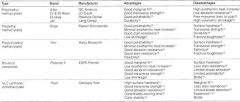
Limited Polishability is a disadvantage of integrity
|
|
|
|
Which of the following alteration to a prepared tooth will improve retention of the abutment?
a) increase taper of axial walls b) placement of groove/box c) decrease surface area d) none |
Placement of a groove/box
|
|
|
|
What is the resin of Jet composed of?
|
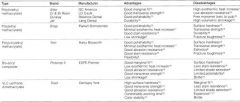
Methyl methacrylate
|
|
|
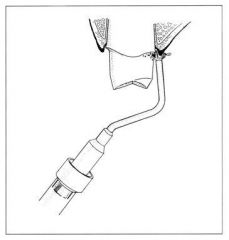
What is the principle chemical retained in ultradent retraction cord?
|
Ferric Sulfate
Fe2(SO4)3 |
|
|
|
Which of the following are symptoms of patients with epinephrine syndrome
a) hypertension b) tachycardia c) anxiety d) post operative depression |
All of these are componenets of epinephrine syndrome.
Also, rapid respiration |
|
|
|
All of the following are characteristics of a prepared tooth for a full veneer crown except
a) abutment b) margin c) finish line d) bevel reduction e) all of the above |
Margin
|
|
|
|
What are the governing factors of tooth preparations?
a)preservation of periodontium b)connector design and location c)resistance and retention d)marginal integrity e)a, c, and d |
a,c, and d
preservation of tooth structure retention and resistance form structural durability of the restoration marginal integrity preservation of the periodontium |
|
|
|
Which is rougher a finishing carbide bur or a diamond bur?
|
diamond bur
|
|
|
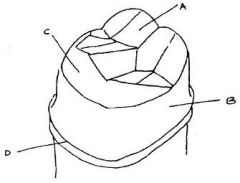
Where is the finish line?
|

D
|
|
|

Where is the axial reduction?
|
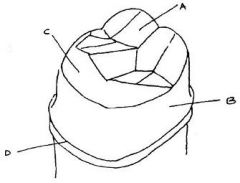
B
|
|
|
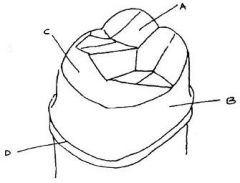
Where is the functional cusp bevel?
|

C
|
|
|

Where is the occlusal reduction?
|
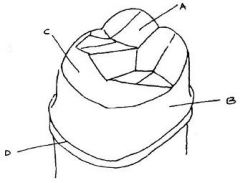
A
|
|
|
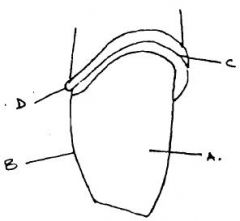
Where is the lingual reduction for this PFM prep?
|

B
|
|
|
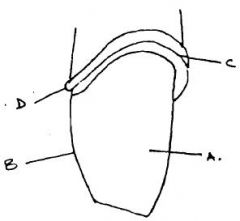
Where is the distinguishing facial finish line for the PFM prep?
|

C
|
|
|

Where is the distinguishing lingual finish line for the PFM prep?
|
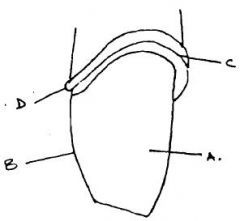
D
|
|
|
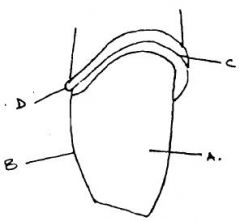
Where is the axial reduction for the PFM prep?
|

A
|
|
|
|
What are the main components of the PFM restoration?
|
Metal coping
Porecelain veneer |
|
|
|
Masking of the metal coping is best accomplished by which of the following?
a) craze line application b) interproximal shading c) opaque layer application maintaining the proper metal coping thickness d) maintaining the proper metal coping thickness |
C
|
|
|
|
The incisal reduction for the anterior PFM preparation follows
a) perpendicular to the facial slope b) lingual to the apical slope c) parallel to the former incisal edge |
B and C
|
|
|
|
The lingual reduction for the anterior PFM preparation is
a) approximately 1.5 mm b) lingual wall should be parallel to incisal aspect of the facial reduction c) maintenance of the cingulum is not necessary d) none of the above |
None of the above
|
|
|
|
T/F
The axiofacial reduction for the anterior PFM preparation is accomplished in two planes, incisal/gingival |
True
|
|
|
|
The length of an anterior PFM facial finish line from the edge of the bevel to the internal axiofacial line angle of the shoulder is 2.0 mm
|
False
1.5 mm |
|
|
|
T/F
The width of the anterior PFM lingual finish line is a chamfer design and is 1.5 mm |
False
1.0mm |
|
|
|
Incisal and occlusal evaluation of all fixed preparations are accomplished by double eye vision under magnification
|
False
Single Eye 30 mm distance |
|
|
|
For the anterior PFM prep "the transition area is that area facial to the interproximal contact and is where the bevel and chamfer finish line terminate
|
False
Lingual to the interproximal contact |
|
|
|
Anterior PFM restoration is characterized by which of the following statements?
a) Utilized in the appearance zone b) Combination of esthetic material and metal substructure c) Optimal esthetics are achieved by more incisal and axial reduction d) all of the above |
All of the above
|
|
|
|
The anterior PFM is characterized by which of the following
a) utilized in the appearance zone b) combination of an esthetic material with metal substructure c) optimal esthetics are achieved by more incisal and axial reduction d) all of the above |
all of the above
|
|
|
|
Which of the following factors influences retention and resistance form?
a) geometric form of the prep b) width of the prep c) length of remaining tooth structure d) all of the above |
all of the above
|
|
|
|
The occlusal reduction for the full veneer crown preparation is which of the following?
a) 0.5 mm b) 2.0 c) 1-1.5 d) none of the above |
1-1.5
|
|
|
|
All of the following are required elements for successful restoration marginal integrity EXCEPT
a) sufficient strength to withstand forces of mastication b) margins that are accessable to the dentist and patient c) chamfer finish line d) close fit against the finish line of the prep |
c) chamfer finish line
|
|
|
|
Axial reduction for the full veneer crown prep is which of the following
a) 2 b) 1 c) 0.5 d) 3.2 |
b) 1.0mm
|
|
|
|
what is the incisal reduction for a PFM?
|
1.5**
|
|
|
|
All of the following are components of a fixed partial EXCEPT
a) retainer b) abutment c) pontic d) connector |
b abutment (tooth prep)
|
|
|
|
A prosthesis that is NOT readily removed by the patient
a) PFM restoratino b) Complete denture c) Partial denture |
a) PFM restoration
|
|
|
|
Tooth preparations are governed by which of the following?
a) gifted operator b) retention and resistance form c) finish line only d) resin cement selected by dentist |
b) retention and resistance form
|
|
|
|
Resistance form is that form of a prep that prevents dislodgement of a restoration by forces directed along the long axis of the prep
|
False Retention
(retention long axis/resistance oblique) |
|
|
|
T/F
Imaginary line along which the restoration will be placed onto or removed from the tooth prep is termed the path of angulation |
False
angle of insertion |
|
|
|
The path of insertion of a fixed restoration is along the long axis of the tooth that is being prepared and is generally inspected from the occlusal or incisal view with no particular attention to single or double eye vision
|
False (single eye vision)
|
|
|
|
What is the definition of prosthodontics?
|
The branch of dentistry pertaining to the restoration and maintenance of oral function, comfort, appearance, and health of the patient by the restoration of natural teeth and/or the replacement of missing teeth and contiguous oral and maxillofacial tissues with artificial substitutes
|
|
|
|
What is the disadvantage of using a retraction cord with ferric salts as the main chemical agent?
a) antiseptic in nature b) acidic in nature c) discoloration of soft tissues d) all of the above |
??
|
|
|
|
What are three characteristics of custom trays?
|
1. Confine
2. Carry 3. Control |
|
|
|
What is the ideal instrument for measuring the finish line?
|
Diamond bur 856-014
|
|
|
|
What is the function of impression material?
|
Record dimensions of oral tissues
Produce negative reproduction of oral tissues |
|
|
|
What are the differences between inelastic and elastic impression material?
a) ability to reproduce fine detail and be removed from undercuts b) set inreasonable time c) can be successfully disinfected |
a) ability to reproduce fine detail and be removed from undercuts
|
|
|
|
What impression material could be disinfected to make another impression?
a) polyether b) agar c) alginate |
agar
|
|
|
|
Agar can be used for accurate crown/bridge impression taking and alginate can't because:
a) alginate = less stable b) alginate = less accurate c) agar sets faster d) agar is more flexible |
Alginate = less accurate
|
|
|
|
Which rubber impression material emits gas after setting reaction?
a) condensation silicone b) polyether c) addition silicone d) polysulfide |
Addition silicone
|
|
|
|
Which rubber impression material has moderate to high tear strength?
|
Polysulfide
|
|
|
|
The setting rate of which inelastic impression material can be accidentally accelerated by exposure to moisture during preparation?
|
ZOE paste
|
|
|
|
Which impression material is the most dimensionally stable elastomeric impression material?
|
Polyvinylsiloxane
|
|
|
|
Which of the following is recommended as an appropriate disinfection procedure for an alginate impression?
a) complete immersion in bleach in a plastic bag for 1 hour b) spraying for 30 sec with an iodophor and then wiping dry c) placing in autoclave on low temp for 3 min d) spraying with gluteraldehyde and sealing in a bag for 10 min |
spraying with gluteraldehyde and sealing in a bag for 10 min
|
|
|
|
Complete mixing of an additional silicone impression material is achieved when the material
a) begins to feel rubbery b) can be poured into an impression syringe c) has uniform color d) no longer sticks to the mixing pad or the spatula |
Has uniform color
|
|
|
|
What are the main components of the PFM restoration?
|
Metal coping
Porcelain veneer |
|
|
|
Masking of the metal coping is best accomplished by which of the following?
a) craze line application b) interproximal shading c) opaque layer application d) maintaining the proper metal coping thickness |
Opaque layer application
|
|
|
|
The incisal reduction for the anterior PFM prep follows
a) perpendicular to the facial surface b) lingual apical slope c) parallel to the former incisal ridge |
b) lingual apical slope
c) parallel to the former incisal ridge |
|
|
|
The lingual reduction for the anterior PFM prep is
a) approximately 1.5mm b) Lingual wall should be parallel to incisal aspect of the facial reduction c) maintenance of the cingulum is not necessary |
NONE OF THE ABOVE
|
|
|
|
T/F
The axiofacial reduction for the anterior PFM preparation is accomplished in two planes, incisal gingival |
True
|
|
|
|
T/F
The length of an anterior PFM facial finish line from the edge of the bevel to the internal axiofacial line angle of the shoulder is 2.0 mm |
False
1.5 mm |
|
|
|
T/F
The width of the anterior PFM lingual finish line is a chamfer design and is 1.5 mm |
False
1.0 mm |
|
|
|
T/F
Incisal and occlusal evaluation of all fixed preparations are accomplished by double eye vision under magnification |
False
single eye 30mm distance |
|
|
|
T/F
For the anterior PFM prep the transition area is that area facial to the interproximal contact and is where the bevel and chamfer finish line terminate |
False
it is actually lingual to the interproximal contact |
|
|
|
Anterior PFM restoration is characterized by which of the following statements?
a) utilized in the appearance zone b) combination of esthetic material and metal substructures c) optimal esthetics are achieved by more incisal and axial reduction |
All of the above
|
|
|
|
The anterior PFM restoration is characterized by which of the following
a) utilized in the appearance zone b) combination of an esthetic material with metal substructure c) optimal esthetics are achieved by more incisal and axial reduction |
All of the above
|
|
|
|
Which of the following factors influences retention and resistance form?
a) geometric form of the prep b) width of the prep c) length of the remaining tooth structure |
All of the above
|
|
|
|
The occlusal reduction for a full veneer crown prep is?
|
1.0-1.5 mm
|
|
|
|
All of the following are required elements for successful restoration marginal integrity except?
a) sufficient strength to withstand forces of mastication b) margins that are accessible to the dentist and patient c) chamfer finish line d) close fit against the finish line of the prep |
Chamfer finish line
|
|
|
|
Axial reduction for the full veneer crown prep is?
|
1.0 mm
|
|
|
|
All of the following are components of a fixed partial except?
a) retainer b) abutment c) pontic d) connector |
Abutment is part of the tooth prep
|
|
|
|
A prosthesis that is NOT readily removed by the patient
a) PFM restoration b) complete denture c) partial denture |
PFM restoration
|
|
|
|
Tooth preparations are governed by which of the following?
a) gifted operator b) retention and resistance form c) finish line only d) resin cement selected by dentist |
Retention and resistance form
|
|
|
|
Who is the author of fundamentals of fixed prosthodontics?
|
Shillingburg
|
|
|
|
T/F
Resistance form is that form of a prep that prevents dislodgement of a restoration by forces directed along the long axis of the prep |
False
Retention = long axis Resistance = horizontal/oblique |
|
|
|
T/F
The imaginary line along which the restoration will be placed onto or removed from the tooth prep is termed the path of angulation |
False
Path of Insertion |
|
|
|
T/F
The path of insertion of a fixed restoration is along the long axis of the tooth that is being prepared and is generally inspected from the occlusal or incisal view with no particular attention to single or double eye vision? |
False
Single eye vision |
|

